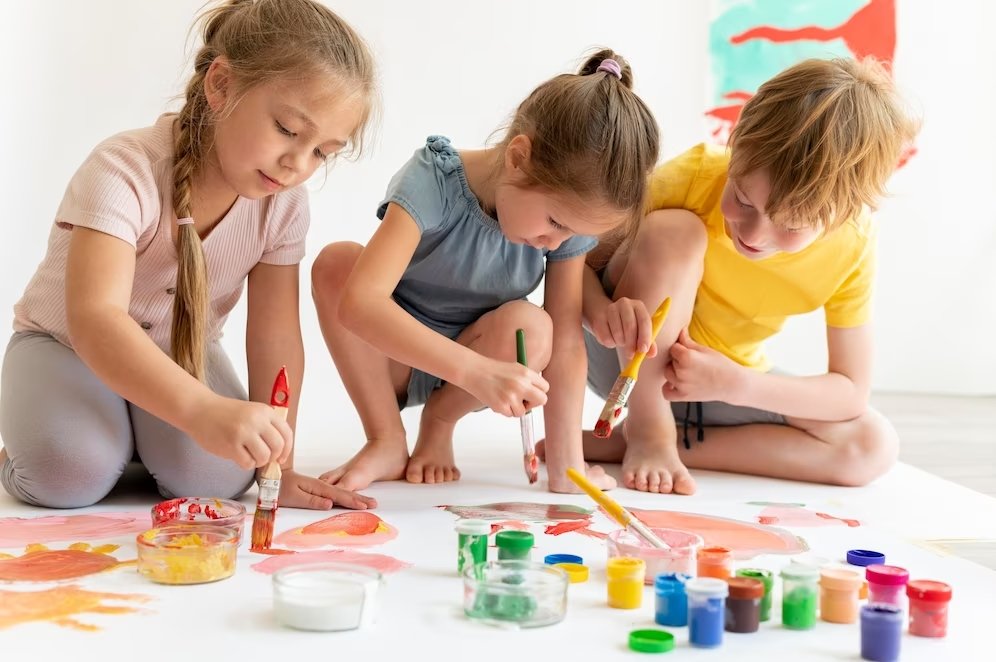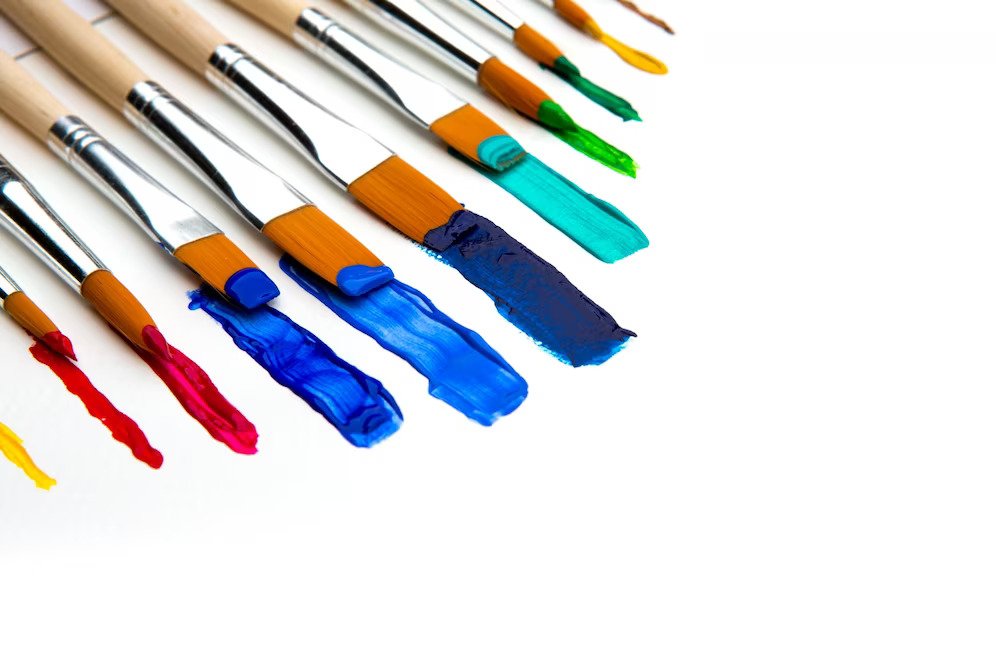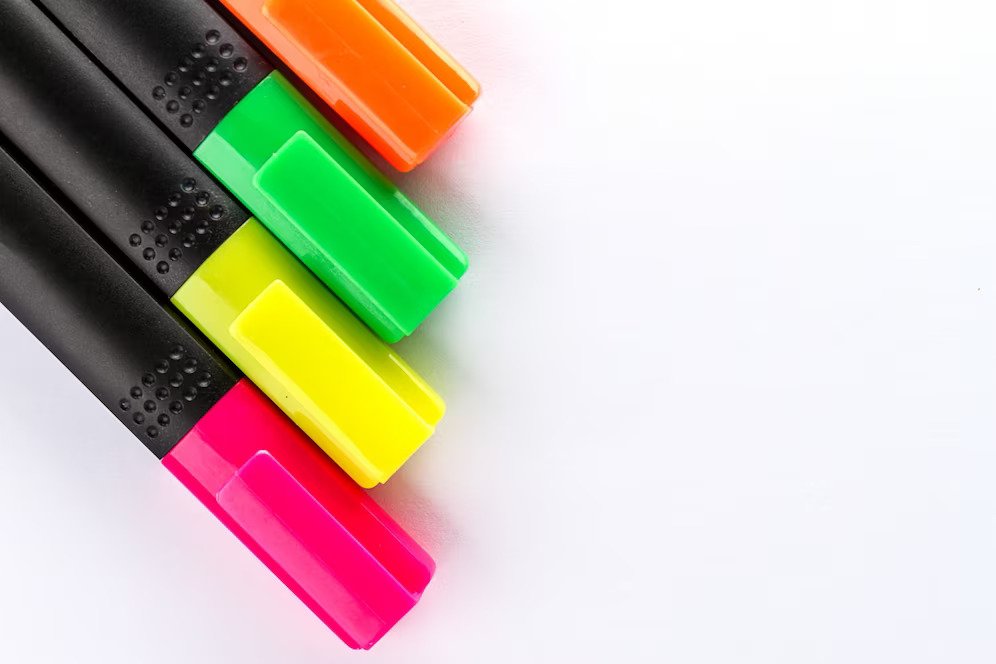I am a parent, trust you me- My kid’s happiness comes first. I know you can relate. As dear parents, children’s happiness are our top priorities. We all cherish those precious moments when our little ones express their creativity through art . However, It’s completely natural to have concerns about the safety of materials our children use, especially acrylic paint when their curiosity knows no bounds. If you’re like me, you might be wondering, “Is acrylic paint safe for my baby?”
Acrylic paint is labeled non- toxic. However, some brands may contain lead which may be harmful if ingested in larger quantity by a toddler. In some cases, a child may experience nausea, vomiting and skin irritation. If your child experiences any of these symptoms, offer water to wash down the paint . If symptoms persist, call poison control((1-800-222-1222, U.S. only).
In this journey of nurturing your kid’s artistic flair, I’ll explore the ins and outs of acrylic paint – including, potential risks. This article will put your mind at ease and ensures your kids’ artistic adventures are not only colourful but also worry-free and memorable.
Related Reading
How Safe is Acrylic Paint for Babies?
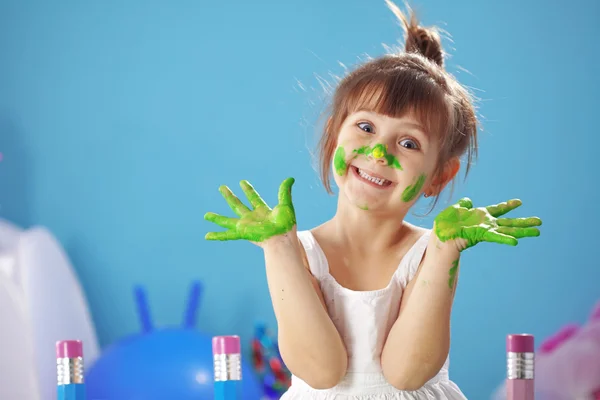

Acrylic paint is safe for babies. Here is why;
1)Acrylic Paint Is Water-Based
When I say acrylic paint is water-based, it means that water is used as a solvent to carry the pigments and binders in the paint. This makes it safe to use, easy to clean up, and less likely to contain harsh chemicals found in other types of paints . The water-based nature of acrylic paint will be gentle on your kid’s skin and makes it a preferable choice for children art projects.
Furthermore, as a water-based paint, its quick-drying nature reduces smudging and the risk of skin irritation. This makes them much safer to use compared to oil-based paints that require harsh solvents for cleaning. While some infants might have sensitivities, patch tests can ensure suitability. This is also one of the reasons it is considered safe for babies.
2) Contains Non-toxic Formulation
Acrylic paint contains non-toxic pigments, binders, and additives that minimize risks associated with traditional solvent-based paints. This formulation prioritizes safety without compromising on vibrant colors or creative potential. These paints are free from harmful chemicals like lead, making them suitable for children’s sensitive skin and minimizing health concerns.
However, as a parent , you should give proper adult supervision and basic precautions because kids may mistakenly ingest acrylic paint in large quantity which can cause some discomfort such as diarrhea, vomiting and nausea. Note that some brands of acrylic paint may contain lead so you should always look out for lead during purchase. I recommend Liquitex BASICS Acrylic Paint Set, it contains the lowest percentage of lead which will not cause any major issues even if ingested.
3) Low – Odor
The great thing about acrylic paint’s safety for kids is that it doesn’t come with those strong, overwhelming smells you might find in other paints. Instead, acrylics have a mild scent that our youngsters can tolerate.
This means less chance of causing breathing troubles or any unwanted feelings while painting indoors. The fact that acrylic paint has this gentle scent adds to the whole art experience – kids can dive into their creative world without worrying about any yucky fumes. It’s all about letting them enjoy their craft time without any worries about anything harmful in the air.
4) Skin-Friendly
I know you are concerned! You’ll be happy to know that acrylic paint isn’t just a creative playground for your kids, it’s also super gentle on their skin. Its really super skin-friendly recipe keeps irritation and allergies at bay. Since acrylics are water-based and steer clear of harsh stuff like lead, you can rest easy. Those little hands dabbling in paint won’t be facing any nasty surprise unless your child is allergic to paint. If your child experiences itching or irritation with acrylic paint, have him/her wear gloves . You can also opt for plastic disposable gloves( Dingion 2000 Pcs Disposable Gloves are easy to use, totally recommend them).
5) Fast Drying and Easy to Use
Here comes my kid’s favorite- Easy to use. Acrylic paint is a safe haven for kids’ thanks to its fast-drying and user-friendly nature. The quick drying time means less smudging and more excitement, allowing your child to enjoy their artistic pursuits without frustration and delays. Generally , it takes acrylic paint 30minutes-60 minutes to dry up when compared to oil paints that take forever. And, after painting, you can easily wash it off with just water and soap saving parents a lot of stress. Acrylic paint is for fun and exploration while minimizing mess and hassle. It’s a 100% safe option and a straight- forward delightful way for kids to express themselves.
6) Acrylic Paint Encourages Expression
Acrylic paint is safe because it is a gateway for kids to express themselves artistically. That’s right, it is a perfect colourful language that lets them convey emotions, stories, and ideas in ways words can’t. As they dip their brushes into vibrant hues, they’re encouraged to paint their feelings and thoughts onto the canvas. With every brush stroke, they gain confidence in sharing their inner world with us.
Whether it’s the light- blue that represents the sky , yellow that gives hope or a mix of reds that captures excitement, acrylic paint gives kids the freedom to communicate their unique perspectives. So, if you’re nudging your child towards painting, you’re actually guiding them towards a wonderful journey of self-discovery and creative expression! I recommend the Top 10 Best Acrylic Paints. And, here are also the Top 10 Best Neon Acrylic Paints to give spark to your Kid’s art paintings
What Age Can Kids Use Acrylic Paint?
Kids as young as toddlers can begin exploring acrylic paint with proper supervision. Around 3 to 4 years old, children usually start to develop the motor skills necessary for basic painting activities. However, the ideal age can vary based on the individual child’s development and comfort level. I’d say, go for non-toxic paints such as acrylic paint. As a parent, I can’t stress enough the importance of getting appropriate brushes, and a safe workspace.
Note: As kids grow, their skills start to evolve, allowing for more intricate and detailed creations. The key here is to ensure a positive and guided experience that nurtures their creativity first while prioritizing their safety and enjoyment.
Is Acrylic Paint Considered Toxic?
Even though acrylic paint is generally considered non-toxic, it’s important to note that some brands might contain traces of lead, which can potentially be harmful if ingested in significant amounts, particularly by young children. Additionally, prolonged skin contact with lead-containing paints can lead to skin irritation and itching to children with sensitive skin. Therefore, it’s advisable to opt for lead-free acrylic paints to ensure the safety of your artistic pursuits. To spot lead-free acrylic paint, here are some steps you can take:
- Check the Label: Look for labels that explicitly state “lead-free” or “non-toxic” on the packaging. Reputable manufacturers prioritize safety and often prominently display these labels.
- Certifications: Some acrylic paints may bear safety certifications from recognized organizations, indicating that they meet certain safety standards. Look for certifications such as AP (Approved Product) seal from the Art and Creative Materials Institute (ACMI).
- Brand Reputation: Research well-known and trusted brands in the industry that have a track record of producing safe and high-quality art supplies.
- Manufacturer Information: Visit the manufacturer’s website or contact their customer service for information about the ingredients and safety of their products.
- Reviews and Recommendations: I do this all the time. Read reviews from fellow artists or parents to gain insights into the safety and quality of specific acrylic paint brands.
- Art Supply Stores: Purchase from established art supply stores such as Amazon that prioritize stocking safe and reliable products.
By choosing lead-free acrylic paints, your kids can enjoy your artistic endeavours without compromising their health.
Recommended Article: Is acrylic Paint Toxic to Dogs?
What Is Astm D-4236 ?
ASTM D-4236 is a standard practice set by the American Society for Testing and Materials (ASTM) that provides guidelines for labelling art materials to indicate their potential hazards and safe usage. This standard was set to ensure the safety of artists, including children when using various art supplies, this includes acrylic paint.
So when you notice the “ASTM D-4236” label on any art product, it simply means it has been tested and marked safe including; toxicity, flammability and other health risks. For parents or anyone purchasing art supplies for children, looking for the “ASTM D-4236” label is crucial.
This label can provide you with peace of mind that the art materials you’re purchasing have been reviewed for potential hazards and are considered safe when used as directed. In essence, seeking the “ASTM D-4236” label is a proactive way to ensure that the art supplies you’re choosing are non-toxic and suitable for all ages, especially for children who might be more vulnerable to potential hazards.
Is Acrylic Paint Toxic to Breathe?
While acrylic paint is generally considered safe to use, breathing in excessive fumes can potentially lead to respiratory irritation or discomfort. To ensure your kids do not breathe in excessive fumes while using acrylic paint, it’s recommended to provide proper ventilation in the painting area.
Open windows or use fans to circulate fresh air, minimizing the concentration of any fumes that may be present. If possible, conduct painting activities outdoors where ventilation is abundant. To also be on a more safer side, buy low-odor or odorless acrylic paints, as they emit fewer fumes. Finally, have your kids paint in a well-ventilated space and take regular breaks to step into fresh air.
What Steps Can You Take if Your Child Ingests Acrylic Paint?
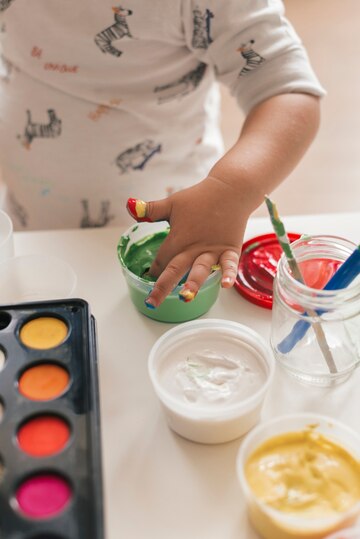

If your child accidentally ingests acrylic paint, it’s important to act promptly but also stay calm. Acrylic paint is generally considered non-toxic, but swallowing a significant amount could potentially cause discomfort or irritation. Here’s what you should do:
- Assess the Situation: Gauge the quantity of paint ingested and any immediate reactions your child might be experiencing. If a child has ingested a large amount of acrylic paint, Missouri poison control advises you give them water to drink. This will help dilute the paint and minimize any potential irritation or discomfort it may cause in the mouth or throat
- Do Not Panic: While ingesting paint is concerning, keep in mind that most acrylic paints are formulated to be non-toxic. Panicking won’t help the situation, so stay composed.
- Rinse Mouth: If your child ingests a small amount of acrylic paint, give them a small amount of water to rinse their mouth. However, it’s important to provide only a small amount of water and avoid overhydrating, as ingesting large amounts of liquid too quickly can also be uncomfortable.
- Contact Poison Control: If you’re worried or unsure about the paint’s toxicity, immediately call your local poison control center. Poison control will provide guidance based on the specific situation at hand.
- Keep Packaging: If possible, have the paint container nearby when contacting medical professionals. They might ask for information from the packaging regarding ingredients.
- Prevention for the Future: To prevent such incidents in the future, ensure that the acrylic pains are marked ” non-toxic” and that painting sessions are supervised. Encourage your child not to put their hands or brushes in their mouth while painting if they are old enough to understand . If you they are less than 4 years, you should always supervise them.
Note, in most cases of accidental ingestion of small amounts of acrylic paint , there is a low chance that
it will cause serious harm. However, it’s always better to err on the side of caution and seek medical assistance if you have any doubts or concerns. Keeping a safe environment during kid’s painting sessions and being aware of how to respond to such situations can provide peace of mind for both you and your child.
Is Acrylic Paint Toxic on the Skin?
Acrylic paint is non-toxic for skin contact. However, it’s essential to note that some children especially those with skin allergies or sensitivities, may experience mild skin irritation. This is more common in cases of prolonged or frequent contact. Additionally, if there are cuts or abrasions on the skin, direct contact with acrylic paint may lead to discomfort.
While these instances are relatively rare and usually mild, it’s recommended to perform a patch test on a small area of skin before extensive use. If your child has sensitive skin, taking precautions such as wearing protective clothing or using a barrier cream can further minimize the risk of any potential irritation ( Read Full Article Here).
Safe Ways to Ensure Your Kid Paint Safely With Acrylic Paint?
Your child’s safety comes first even as they paint. For a parent , there are things you should do to create a safe painting environment. This can be a combination of preparation, supervision, appropriate precautions or both. Whenever my baby girl paints, I use these safe ways to facilitate a worry-free painting experience for both of us;
- Choose Non-Toxic Paints: This is a no- brainer. Choose acrylic paints labeled as “non-toxic” or “safe for children.” Non- toxic acrylic paints have formulations that free from harmful chemicals, making them suitable for young artists.
- Designate a Safe Space: Set up a well-ventilated and organized painting area. This can be indoors or outdoors, but ensure there’s ample ventilation to disperse any fumes.
- Protective Clothing: Have your child wear old clothing or an apron to safeguard their clothes from paint splatters. Long sleeves and pants can come in handy for this moment while providing an extra layer of protection.
- Use Child-Safe Brushes: Choose brushes designed for kids. These are typically softer and gentler on their skin. Avoid brushes with sharp ends that could potentially cause harm.
- Adult Supervision: Always supervise your child while they paint. A lot of parent do not get this. I know you have other things to do but supervising your child as he/se paints will ensures their safety but also offers the opportunity for guidance and learning.
- Patch Test for Sensitivity: If your child has sensitive skin, perform a patch test on a small area before painting extensively.
- Hand Hygiene: Encourage your child to wash their hands before and after painting. This reduces the chances of accidentally transferring paint to their face or mouth.
- No Eating or Drinking: Teach your child not to eat, drink, or put their hands in their mouth while painting. This prevents accidental ingestion of paint.
- Breaks and Clean-up: Schedule regular breaks during painting sessions. Use these breaks to wash hands and clean up any paint smears. Also, provide a designated area for drying artwork.
- Non-Skin Contact: Minimize direct skin contact with paint, especially if your child has cuts, abrasions, or sensitive skin. If needed, provide gloves to protect their hands.
- Clean Hands Properly: After painting, ensure your child cleans their hands thoroughly. Acrylic pant can easily be washed off using soap and water to remove any paint residue.
- Proper Storage: Store acrylic paints out of reach when not in use. This prevents accidental spills and exposure.
Safe Craft Paints for Kids
If you want to get your child started on painting, I am happy to introduce you to 5 cool, non- toxic and easy to use craft paints. I have listed my daughter’s favorite acrylic paints, water color paints and finger paints. She is 4 years old. I am confident your child will absolutely fancy them- these paints can be used straight from the bottle;
1) Acrylic Paint-Apple Barrel PROMOABI Acrylic Paint Set, 2 Fl Oz (Pack of 18), Assorted Matte Colors


Pros
- Gives a Matte Finish
- Fast- Drying
- Suitable for various surface including wood, Styrofoam, plaster, terra cotta, and more.
- You get 18 cool colors
Cons
- Does not give a glossy finish
2) Sax True Flow Heavy Bodied Acrylic Paint – 1/2 Gallon


Pros
- Gives a Matte Finish
- Easy to Clean Up
- Perfect for Art Classrooms
- Can be used on many surfaces such as; canva, wood, plastic, ceramics, walls and paper.
Cons
- It does not give a glossy finish.
3)Water Color Paint ( I recommend Crayola Washable Watercolors, 12 Paint Sets for Kids, School Supplies Bulk, 8 Vibrant Colors)


Pros
- Watercolor paint
- Best for paper surfaces
- Ideal for 3 year old kids and above
- Non-Toxic
- Comes in 12 color set
Cons
- It is not acrylic
4) Washable Tempera Paint for Kids, Magicfly 30 Colors (2 oz Each)


Pros
- Gives a metallic finish
- Washable
- Comes in 30 colors
- Best for kids of 3 years and above
Cons
- Only suitable for Fabric
5) Finger Paints( I recommend Jar Melo Safe Finger Paints for Toddlers)


Pros
- Silky Texture
- Washabe
- Non- allergic
- Best for kids of Age 2 3 4 5 6+
- 12 cool assorted colors
Cons
- Could not find any
Perfect Craft Projects for Your Kids
Here are some cool painting craft projects for kids;
- Fingerprint Art: Have kids create pictures using just fingerprints as the main design element.
- Sponge Painting: You can tell kids to dip sponges in paint and stamp them on paper to create textured patterns and images.
- Bubble Wrap Printing: Dip bubble wrap in paint and press it onto paper for a unique textured effect.
- Nature Prints: Paint leaves, flowers, or other natural objects and press them onto paper for imprints.
- Painted Rock Creatures: Transform smooth rocks into creatures by painting faces, patterns, and details on them.
- Silhouette Scenes: Paint colourful backgrounds and create silhouette scenes on top using black paper cut-outs.
- Marble Painting: Roll marbles dipped in paint around a tray to create abstract, swirly designs on paper.
- String Pull Art: Dip strings in paint and lay them on paper, then lift to reveal a unique pulled design.
- Blow Painting: Drop liquid paint on paper and blow it around using a straw to create abstract patterns.
- Spin Art: Place paper on a spinning platform and drop paint, creating mesmerizing symmetrical patterns.
- Wax Resist Painting: Draw designs with crayons on paper, then paint over with watercolors for a resist effect.
- Tape Resist Art: Apply tape to paper in a design, then paint over it to reveal a sharp, clean design underneath.
- Canvas Collage: Paint individual canvas squares and arrange them into a larger collage artwork.
- Color Mixing Exploration: Let kids explore color mixing by providing primary colors and encouraging them to create new hues.
- Abstract Expressionism: Allow kids to freely paint using bold strokes, splatters, and shapes to express their emotions.
- Texture Exploration: Experiment with different tools (sponges, forks, brushes) to create textured paintings.
- Storybook Illustrations: Paint scenes from their favorite stories or create illustrations for their own made-up tales.
Feel free to adapt and modify these ideas to suit your kids’ interests and the materials you have available.
Can You Use Acrylic Paint for Handprints and Footprints?
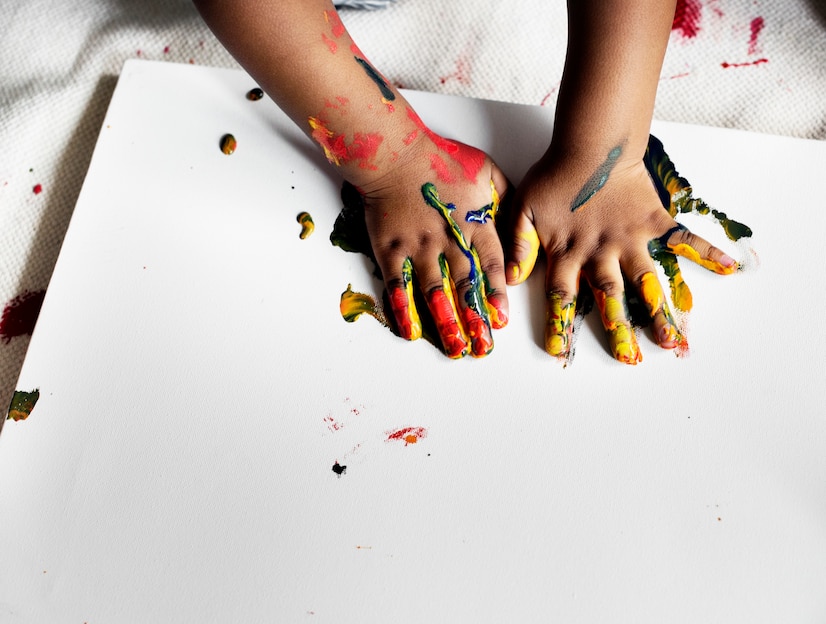

Absolutely, you can use acrylic paint for handprints and footprints. It is undoubtedly the perfect choice for handprints and footprints because it provides vibrant colors and adheres well to various surfaces including paper, canvas, and wood. However, you should ensure that the acrylic paint you use is non-toxic and safe for your child’s skin.
Ways to Remove Acrylic Paint from Baby’s Skin , Feet or Hands
Removing acrylic paint from a baby’s skin, feet, or hands requires gentle and safe methods to ensure their comfort and well-being. Here are several effective ways to easily remove acrylic paint without causing any harm;
- Water and Soap: The simplest and safest method is to wash the painted area with warm water and mild baby soap. Gently lather the soap on the painted skin and rinse with water. This method is usually effective for fresh paint.
- Baby Oil or Olive Oil: Apply a small amount of baby oil or olive oil onto a soft cloth or cotton ball and gently rub the painted area. The oil helps to loosen the paint from the skin. Afterward, wash the area with soap and water to remove the oil residue.
- Petroleum Jelly: Applying a thin layer of petroleum jelly over the painted skin can help soften and lift the paint. Let it sit for a few minutes, then wipe off the paint and jelly with a soft cloth.
- Coconut Oil: Coconut oil is another safe option. Apply a small amount and gently massage it onto the painted skin. Wipe away the paint with a cloth, and then wash the area with soap and water.
- Baby Wipes: Some gentle, non-toxic baby wipes can help remove acrylic paint from baby’s skin. Use wipes that are free from harsh chemicals.
- Warm Bath: If the paint is on larger areas like the hands or feet, consider giving your baby a warm bath. The water will help soften the paint, making it easier to gently rub off.
- Avoid Harsh Chemicals: Avoid using harsh chemicals, acetone, or nail polish remover on a baby’s delicate skin. Stick to mild and natural solutions.
- Patience and Gentle Rubbing: Regardless of the method you choose, patience is important. Avoid forcefully scrubbing the paint off, as this can irritate the skin. Instead, use gentle rubbing motions.
Remember to maintain a calm and soothing environment during the paint removal process. Engage your baby with toys or soothing music to distract them if needed. After successfully removing the paint, moisturize the skin to prevent any dryness.
Expert Advice
Nail polish remover and rubbing alcohol can also be used to remove acrylic paint from skin. However, when dealing with babies or young children, it’s essential to exercise extra caution due to the potential for skin sensitivity. Here’s how to use these methods safely:
- Nail Polish Remover (Acetone-Free): Choose a gentle, acetone-free nail polish remover. Apply a small amount to a cotton ball or soft cloth and gently dab the painted area. Make sure to avoid contact with the eyes, mouth, and any broken skin. Wash the area with mild soap and water after removing the paint.
- Rubbing Alcohol (Isopropyl Alcohol): Use rubbing alcohol with a low concentration (70% or lower) to prevent skin irritation. Moisten a cotton ball or soft cloth with the alcohol and gently rub the painted area. Again, avoid sensitive areas too and broken skin. Afterward, wash the area with soap and water.
When using nail polish remover or rubbing alcohol on a baby’s skin, always follow these precautions:
- Patch Test: Test a small, inconspicuous area of skin first to ensure there’s no adverse reaction or irritation.
- Gentle Application: Use a gentle touch and minimal pressure when applying the nail polish remover or rubbing alcohol.
- Avoid Sensitive Areas: Keep these substances away from the face, eyes, mouth, and genital areas.
- Rinse with Water: After using nail polish remover or rubbing alcohol, be sure to rinse the area with water and mild soap to remove any residue.
- Moisturize: After removing the paint, moisturize the skin with a baby-safe lotion to prevent dryness.
Always prioritize the safety and comfort of your baby when choosing and applying paint removal methods.
Frequently Asked Questions
What Is the Safest Paint for Baby Cot?
Milk paint is made from natural ingredients like milk protein, lime, and earth pigments. It’s a safe and eco-friendly option that creates a matte finish.
What Kind of Paint Is Safe for Babies Skin?
Water- based paints such as Tempera paints are ideally safe for babies’ skin. It is all non- toxic and does not pose a threat to skin.
Is Acrylic Paint Safe for Baby Crafts?
Acrylic paint is non- toxic . It is safe for use on baby crafts. It is also easy to clean up .
Is Acrylic Paint Safe for Baby Crib?
Acrylic paint may contain a low percentage of lead and ammonia which may be harmful if ingested in large quantity. The best paint for baby crib is real milk paint because it contains zero- VOC.
Final Thoughts
There you have it dear parent. The ultimate power to make your kid’s creative environment fun and entertaining lies in your hands. With acrylic paint, their creativity is guaranteed to shine even more. From beautiful handprints that capture their imagination and to painting on canvas , acrylic paint opens up a world of possibilities for your child’s artistic expression and perspective. Help your child bring bring their ideas to life.


